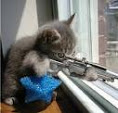For some reason that I've long since forgotten, there was some brouhaha between the US and the USSR in the late 1970s/early 1980s over the placement of nuclear missiles.
The Soviets moved their ICBM patrols into the western Atlantic. That would have given them the ability to make a
depressed-trajectory shot, which would have really cut the reaction time available to the Americans.
Needless to say, the Americans were not happy with that. Among other things, TACTASS-equipped ships were sent out to search for and track the Soviet submarines. This operation, in part, took place in the winter.
One does not have to be a naval expert to know that during the winter, the North Atlantic is a challenging place to be.
TACTASS, designated the AN/SQR-18A, attached to the back of the fish of an AN/SQS-35 variable depth sonar (VDS). This is a photo of an apparently Japanese setup:
The fish itself was well-weighted by a goodly amount of lead. The red arrow points to where the towed array was attached. What would happen is the array would be payed out from a reel in a room next to where the VDS fish was housed. The array would then be mated both mechanically and electrically to the VDS fish. Then the fish would be launched. In moderate to heavy seas, this was a wet operation. The side doors, at least, were operated by hydraulics. The crane and cable reel had an operator's station with a waterproof door. Once the array was mated, everyone would leave the room, except for the operator, and the fish would be launched.
As you can see here, the cable between the ship and the VDS fish was faired, with aluminum leading edges and rubber trailing edges:
So now picture that you have a heavy fish being towed by a long cable, which had no elasticity. In a heavy sea, the stern of the ship moved up and down a lot, which jerked on the fish. The cable wouldn't break, but the electrical connections were not as durable, especially the connections between the fish and the array, which itself was several hundred feet long and streamed behind the fish. A fair number of the tracking missions ended with the ship returning to port to replace the towed array, which was shipped on a large cable reel.
Because the weather was often bad enough to preclude the ships from launching their SH-2Fs to localize any contacts, S-3s were sent out to do that work. I don't recall whether or not they flew out from Norfolk and Mayport or if they staged out of NAS Bermuda.
So there was a ship out doing that, and there was a S-3 that was sent out to do its thing. The S-3 told the ship (over secure voice radio) that there was an unknown error in its internal nav system. The ship's ASW officer, who was on watch, asked how large the error was. He was told that it was about a dozen miles or so. The ASW officer advised the S-3 to "mark on top" (fly directly over the ship) and the ship could give them an accurate position so the S-3 could update its navigation picture and thereby greatly reduce the error.
The S-3 refused to do that. They then asked the ship where they should being dropping sonobouys and in what pattern. The ASW officer replied on the order of "I won't know within a hundred square miles of ocean where those buoys are, so it makes no difference to me where you drop them." (The ship was operating on an EMCON [emissions control] plan and it could not use its air-search radar to track the S-3.)
And that was pretty much it. For the rest of the time the S-3 was on station, it flew around, doing something that generated no useful information. When it either ran low on fuel or used up its sonobuoys, it returned to base.
On that ship, the ASW officer wrote the post-patrol report, which was sent off as a radio TTY message. The draft of the report (and all other radio messages) typically was written by hand on a yellow legal pad, either double or triple-spaced. The
Weapons and
Operations officers reviewed the draft and edited it before it was sent to the CO for his review and approval. This time around, the Captain noticed that the draft was written in the hand of the Weapons officer. When the CO asked why that was so, the Weapons officer said that the ASWO wanted to re-enact the Crucifixion, with the S-3 playing the starring role.
Eventually, with the deployment of the
SURTASS ships, the use of the SQR-18A ships for tracking Soviet SSBNs was discontinued.
